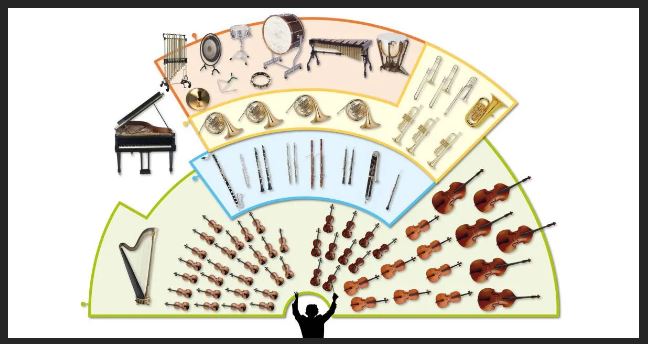I want to explain something that most people have zero exposure to: a symphony orchestra. I had the good fortune to play in a school symphony in 1972-1973. We went to competitions. We went to see the movie “Fiddler on the Roof” and experience in surround-sound the amazing music in that film as we were playing the theme. We played at school events. Playing in that group was the epitome of my life, I think, after my kids. But I get it: most people don’t know much about how orchestras work.
Here’s a chart:

We see the strings: the harpist (if there is one) and the violins, violas, cellos, and the basses behind them. Then we get the woodwinds in the center middle. That’s piccolo, flute, clarinet, oboe, bassoon. Then the brass is behind them: trumpet, trombone, euphonium, cornet, tuba. And further back is the percussion section, all the bang-y bits: drums, xylophones, chimes, timpani, gong, various hand-held struck or scraped or shaken things. If there’s a piano, it’s back there behind the harp or next to the violins if no harp.
Watch this piece by one of my favorite composers for some up-close section shots as well as 23 minutes of amazing musical performance.
One observation you might make is that instruments of a particular type are very similar, but different sizes. True. With the strings, we get bigger, but the strings are all usually tuned in “fifths”, but only getting fatter and longer, larger sound boxes, lower tones. The blown instruments also get longer and larger. The woodwinds operate by blocking tone holes to change the length of the air blown through. The brass uses valves (or in the case of a trombone, extra plumbing) to lengthen their instrument and change the tone.
The type of playing also varies between sections. Strings are bowed or plucked. You blow a reed on a clarinet or purse your lips into a cupped brass mouthpiece. The ways of interacting with an instrument are varied, even within one single instrument. I can bow my cello gracefully or “chop” it more percussion-like. I can pluck the strings with my fingers instead of using a bow.
A symphony orchestra is only one small portion of the world of music. See composer David Bruce’s Map of Music (or anything else David puts out!) for an incredible overview of music that will knock your socks off and make you want to join in.
Why do I write about this today? Well, it’s the next step perhaps in my belief that the world is changing, and for the better ultimately. We have some terrible losses in this crazy time. It’s been stressful.
But if some scholars are correct, human beings as groups undergo this same turmoil from time to time throughout the annals of history. There are times when things go relatively peacefully and prosperously. Other times, things are ripped and torn bloody by conflict. There are folks who are gloom-and-dooming that the world is going to end – and they are correct, but only in a sense.
Orchestral music came to the fore and was ripped by the “establishment” for how heinous and vulgar the music was. How dare you take the gentle quartet and add all those OTHER people to it!! We need a bigger living room!!! And who’s going to pay all those guys?!? Symphonies and their music responded to the times when there was money and leisure and more educated folks who sought out rich, complex musical ideas.
Now, fewer people attend the symphony, but when they do, the music has evolved from the above-referenced Resphigi (did you go listen to it? Shame on you if you didn’t.) to more of David Bruce’s contemporary compositions (like this one: https://www.youtube.com/watch?v=YwawS6f-m40 ; you can see David recording them near the conductor) that stretch what an orchestra necessarily does. The truth is film scores are very often symphonic, even if composed digitally. And we are fortunate that we have not only orchestras, but bands and music communities spanning the globe that we have access to.
Having a “global” world doesn’t have to be, nor should it be, vanilla. The elitist cabal would have you believe it does, though. That’s a much easier paradigm for them to manage. But there can be a world as diverse as the symphony orchestra, with various players, parts, music, timbres, tones, and methods that create an amazing interlaced transcendent experience. We can do it with 120 musicians, and trust me – musicians are the worst!
I’m not naïve–the world scale alone IS daunting. And there are people in it who demonstrate that they can’t be trusted.
But it can happen. We have to believe it can for it to have a chance.
What’s YOUR instrument? What’s your part? What contribution will YOU make to the music?
(And for the love of Pete, don’t just stand there complaining.)
For further information on this deep topic, read “Horton Hears a Who”. I think Dr. Seuss was more prescient than we knew. Or maybe he wrote for the kids of that day who are now the aging Boomers today. (Or watch it here: https://youtu.be/B-i1E1UbwVI )
(Disclaimer: I get nothing from David Bruce for mentions in this blog post. I subscribe to his YouTube channels and to his 8notes.com website where I can get sheet music and play-alongs. He’s an amazing modern composer, entertaining and informative YouTuber, and totally decent human being, ref his corporate charitable giving at https://www.8notes.com/help/charity.asp .)
